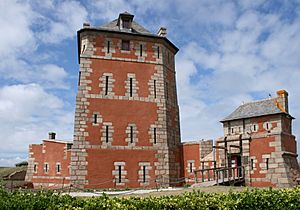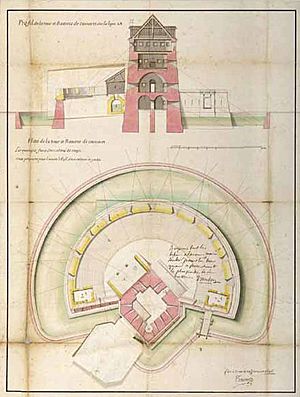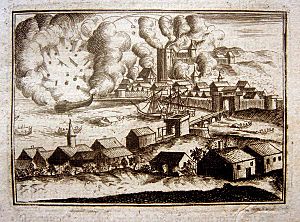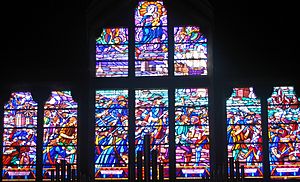Battle of Camaret facts for kids
Quick facts for kids Attack on Brest |
|||||||
|---|---|---|---|---|---|---|---|
| Part of the Nine Years' War | |||||||
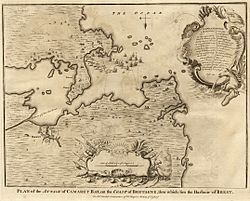 English plan of the battle of Camaret |
|||||||
|
|||||||
| Belligerents | |||||||
| Commanders and leaders | |||||||
| Strength | |||||||
| 10,000-12,000 men 36 ships of the line 12 bomb ships 40 or 80 troop transports |
1,300 men 265 guns 17 mortars |
||||||
| Casualties and losses | |||||||
| 1,100 killed or 1,200 killed or wounded 466 captured (including 16 officers) 2,000 killed or wounded and 1,000 captured 1 ship of the line sunk and another captured 5 ships of the line badly damaged Many longboats lost, including 48 captured |
45 wounded (including 3 officers) | ||||||
The Battle of Camaret, also called the Brest expedition, was an important fight during the Nine Years' War. On June 18, 1694, a large force of 10,000 to 12,000 English and Dutch soldiers tried to attack Brest. They thought the city would be easy to capture because the French fleet had sailed away. Brest was a very important French naval base.
However, the French knew about the attack. Only a little over a thousand French troops, led by Sébastien Le Prestre de Vauban, defended the city. This was Vauban's only time leading troops in a battle. The fight involved fierce shooting between ships and cannons, and a ground battle. The allied landing party was pushed back to the sea. The battle ended in a quick defeat for the English and Dutch, who had to retreat.
Contents
Why the Battle Happened
In early 1694, King Louis XIV of France decided to send his navy to the Mediterranean Sea. He wanted to help his army capture Barcelona in Spain. He also hoped to make Spain sign a peace treaty. So, the French fleet, led by Admiral Tourville, left Brest.
When the English and Dutch heard about this, they planned to attack Brest. They believed it would be easy to take the city without the French fleet there. They planned to land a large army of 7,000 to 8,000 soldiers.
After a French naval victory in 1693, William III of England wanted to strike back at French ports. King Louis XIV learned about the plan against Brest from his spies. He then made Vauban the military commander of Brest and the surrounding areas.
Getting Ready for Battle
The English and Dutch gathered a large fleet in Portsmouth. It was led by Admiral Berkeley. The fleet included 36 warships, 12 fireships, and 80 transport ships. These ships carried about 8,000 soldiers, making a total force of over 10,000 men. General Thomas Tollemache was in charge of the soldiers.
Vauban immediately started organizing the defense of Brest and its rocky coast. Bad weather kept the English fleet in its harbor for a month. This gave the French just enough time to get ready for the attack.
French Defenses

Vauban had been planning defenses for the French coast for a long time. In 1685, he wrote about the importance of defending places like Camaret Bay. He knew it was a spot where enemy ships could hide.
When the war started, Vauban decided to build strong defenses. He set up a fort at Fort de Bertheaume. He also started building a special tower, the "tour de côte", at Camaret. This tower was unique. The English knew about these building efforts and tried to destroy the tower in 1691. However, French ships drove them away.
Vauban understood that he had a very long coastline to defend. So, he decided to build forts in several key places. These forts would be manned by local militias but could be quickly reinforced by regular troops.
Allied Attack Plans
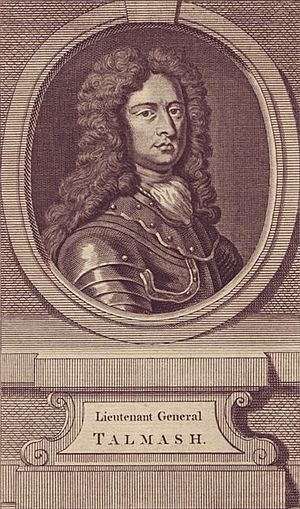
In early 1694, when the English heard that Admiral Tourville had left Brest, King William III thought Brest would be easy to capture. He decided to launch his attack.
The plan was for most of the English and Dutch fleet, led by Admiral Russell, to sail to Barcelona to fight Tourville. The rest of the fleet, under John Berkeley, would land an invasion force near Brest. This force, led by Lieutenant-General Thomas Tollemache, would take control of the entrance to Brest harbor. The English believed that controlling this entrance was key to taking Brest.
As the English threats grew, King Louis XIV made Vauban the "supreme commander of all French land and sea forces in Brittany." Vauban accepted, but he knew the odds were against him. When he arrived in Brest on May 23, the city had only about 1,300 defenders. Even with expected reinforcements, it would be a tough fight.
The allied fleet sailed on June 1, 1694. Meanwhile, Vauban worked hard to build more forts and strengthen existing ones along the coast. By mid-June, he realized that Camaret Bay was a likely landing spot for many troops. He ordered it to be reinforced. He also armed local militias and organized a system of signals to quickly share information.
On June 17, Vauban wrote to King Louis XIV. He reported that he had ordered more defenses to be built. He also said that five or six days of work would make the coast strong enough to defend.
The Battle Begins
June 17, 1694
The English and Dutch fleet, with 36 warships and 80 transport ships, finally set sail. On the evening of June 17, Vauban received signals that the fleet was near Brest. It anchored between Bertheaume and le Toulinguet, close to the entrance of Brest harbor.
Rear Admiral Marquess of Carmarthen went closer to the French coast to check their defenses. When he returned, he said the defenses looked very strong. But Admiral Berkeley and General Talmash thought he was overstating the danger. They decided to attack the next morning. The English did not know that the French reinforcements had not yet arrived.
June 18, 1694
On the morning of June 18, a thick fog covered the area. This made the English delay their attack. The fog helped the French, as more troops and militias arrived.
Around 11 o'clock, the fog lifted. Carmarthen moved forward with eight ships to attack the Tour de Camaret. These ships were meant to protect the 200 small boats carrying soldiers to the beach at Trez-Rouz.
The Tour de Camaret, supported by other French cannons, fired heavily. Two English ships caught fire, and others were badly damaged. The English fired back, hitting the tower several times. One cannonball even hit the spire of the Chapelle Notre-Dame de Rocamadour. A local story says that the Virgin Mary appeared and sent the cannonball back to the enemy ship, sinking it.
Meanwhile, General Tollemache landed on Trez-Rouz beach with 1,300 men. They immediately faced heavy French fire. French soldiers and 1,200 coastguard militiamen then charged them.
The English troops were cut down quickly as they tried to land. Tollemache himself was hit in the thigh by a cannonball as soon as he stepped on shore. He was carried back to his boat. His men got back into their boats in confusion. Ships and boats quickly tried to leave the bay. But not before 400 sailors and 700 soldiers were killed. For many days, bodies washed up on the beaches of Brittany. The place where Tollemache was wounded is still called "the Englishman's Death."
The French counter-attack pushed the enemy back to the sea. The landing troops could not retreat easily because the tide had gone out, leaving their boats stuck. Only ten of these boats managed to get back to the English fleet.
The English losses were very high. About 800 landing troops were killed or wounded. Another 400 men died on the ships. 466 were taken prisoner, including 16 officers. The French, however, had only about 45 wounded.
Since that day, the landing beach, stained red with blood, has been known as Trez Rouz (red beach). The cliff nearest to where Talmash landed is still called Maro ar saozon (the Englishman's death).
Vauban was not at the battlefield during the main fight. He arrived after it was over. He wrote that the enemy had planned their attack well but did not carry it out so well.
What Happened Next
General Tollemache died from his wounds after returning to Plymouth, England. People in England were very sad and angry about the defeat. After this loss, the English and Dutch fleet sailed back up the English Channel. They bombed French ports like Dieppe and Le Havre in revenge. Le Havre was badly damaged after five days of bombing. Later, the same fleet attacked Dunkirk and Calais. But these cities had strong defenses and only suffered minor damage.
This attack gave Vauban a chance to make the coasts around Brest even stronger. He added new defenses at Portzic, île Longue, and Plougastel.
To celebrate the victory, King Louis XIV had a special medal made. It said "Custos orae Armoricae" (guard of the coast of Armorica) and "Angl. et Batav. caesis et fugatis 1694" (the English and the Dutch routed and put to flight 1694). Also, the people of Camaret were freed from certain taxes because of their bravery in the battle.
The "Camaret Bay Letter"
After this defeat, some people looked for someone to blame. Many accused John Churchill, a famous English general. He was accused of sending a letter to the former King James II in May 1694. This letter supposedly warned James II about the attack on Brest. This became known as the Camaret Bay letter.
The letter, translated into French, said that the attack on Brest was planned to burn the port and destroy warships. It claimed that the writer was telling James II this information because he believed it would help him. It also asked James II to keep the information secret.
Historians debate if this letter was real or a fake. Winston Churchill, a descendant of John Churchill, believed it was a fake. He thought it was made to harm Marlborough's reputation. Even if Marlborough did send a message about the attack, the French already knew about the plans from other spies. So, it's not clear if the letter truly affected the battle's outcome.
Remembering the Battle
In the Saint-Rémi church, there is a large stained-glass window that shows the battle. It was designed by Jim Sévellec.
See also
- Goulet de Brest (with links to most of the fortifications along it, many of which were built by Vauban)
- Camaret-sur-Mer
- Tour Vauban
- Combined operations and the European theatre during the Nine Years' War, 1688-97



